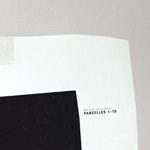
CD, Bruit Clair, 2010
www.mathiasdelplanque.com
Born in Burkina Faso but trained in classical music studies at the Ecole Nationale d’Arts de Cergy Pontoise in France, Mathias Delplanque has since immersed himself in electronic music and sound art. With a laundry list of projects, collaborations, visual work and space/sound installations behind him, the release of “Parcelles 1-10”, his seventh solo album under his own name, comes as a sequel to “Le Pavillon Témoin” (2007) and is itself the first installment of a planned trilogy of albums.
But in fact the concept goes a bit deeper. According to Delplanque’s website, the entire “Parcelles” series – this and the two forthcoming works – take place between the final two tracks on “Le Pavillon Témoin”. It is a divergence that will, following the last composition of the trilogy, conclude with the ultimate track on “Le Pavillon Témoin”. In short, the whole thing will become a fascinating sound insertion, a hypothetical auditory space flourishing within the predefined parameters of a larger framework.
“Paracelles 1-10”, released on Delplanque’s own Bruit Clair label (launched July 2009), was recorded live in the studio with direct sound takes and no re-recording. It is a curious and ambient digression that, besides utilizing the computer as instrument, engages other elements such as melodica, guitar, zither and unspecified percussion. Although its musique concrète impulses are compelling, the recurrent cyclical patterns invoked by its drone tendencies are where this experimental album’s power is rooted.
Full of plaintive guitar and shimmering tones, irregular playback, creaks and scrapes, stumbling manipulations and whispering atmospheres, the album flows seamlessly from one track to the next, each in some manner reminiscent of those both before and after. This is accomplished via a sort of familiarity déjà vu. For example, what seem to be found sounds, like the rusty springs and hinges in “Parcelle 3”, or what might be tapping bamboo sticks in “Parcelle 9”, carry through the warren of micro-sounds, self-altering while infiltrating other spaces within this already tangential opus. Similarities crop up, but subtle differences facilitate progress.
The pervasive background movements in “Parcelle 5”, the calm and stretched tones in “Parcelle 10”, the juxtaposition of shifting tableware and deep bass reverberations in “Parcelle 8” – each aspect its own microcosm in the larger whole, imbibing “Paracelles 1-10” with a unique spatial sense, one that is at once boundless and claustrophobic. Amassed as a single entity, these individual parcels and the cycles therein become, in a way, timeless. Which is exactly how the insertion of a hypothetical sound space into the pre-existing fabric should be perceived.
[8.5/10]
— Dutton Hauhart
